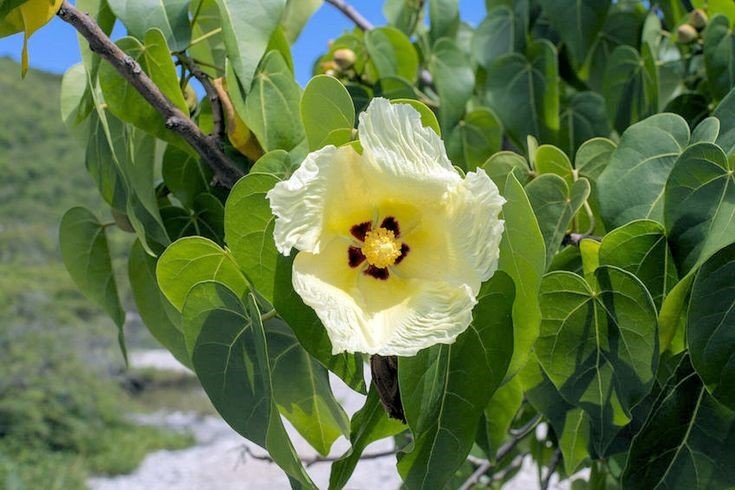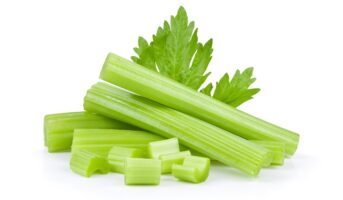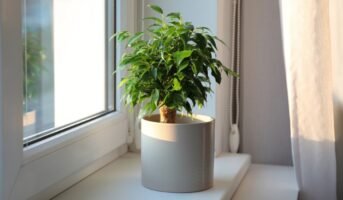Thespesia Populnea is a small tree that is found all over the world. The plant is also known by its common names like portia tree, Pacific rosewood, Indian tulip tree, or milo tree. Thespesia Populnea is popularly found in the coastal regions of the world. The plant belongs to the mallow family named Malvaceae. Currently, the plant has been declared as an invasive species in Florida and Brazil.
See also: Polka dot plant: Why should you get one?

Source: Pinterest
Thespesia Populnea is a comparatively small tree that rises to a height of 20–33 feet. Its smaller trunk can measure up to 7.9–11.8 inches in diameter. Thespesia Populnea prefers areas that receive moderate rainfall. During the blooming season, the plant produces yellow flowers with a maroon centre. These flowers are small in size and shaped like small funnels.
Thespesia Populnea: Key facts
| Name | Thespesia Populnea |
| Common names | Portia tree, Pacific rosewood, Indian tulip tree, Milo tree |
| Type | Tropical |
| Flowers | Small and yellow |
| Soil | Any type of soil |
| Temperature | 20–26°C |
| Water | Plenty |
| Sunlight | Full sun |
| Indoor/Outdoor | Outdoor |
Thespesia Populnea: Genus
Portia tree belongs to the Thespesia genus, which comprises 13 flowering trees and shrubs in the Malvaceae family, which is also commonly known as the Hibiscus family.
Thespesia Populnea: Native habitat
Thespesia Populnea is most likely native to to Hawaii. However, it may have been introduced to Hawaii by the early Polynesians. This plant is found throughout the tropics across coastal areas, particularly where sandy beaches give way to coral outcrops. Thespesia Populnea is also quite widespread on rocky coasts and sometimes on the inland edge of mangrove swamps.
Thespesia Populnea: Sun tolerance
Thespesia Populnea absolutely requires sunlight to survive. For best results, they should be planted in full sunlight. It can easily tolerate full direct sunlight.
Thespesia Populnea: Mature height
When fully mature, Thespesia Populnea can grow up to a height of 10 metres.
Thespesia Populnea: Leaves
Leaves of Thespesia Populnea are thin and broadly heart-shaped around 3-5 inches in size. They are arranged spirally and rather fleshy and shiny with both surfaces covered in small scales.
Thespesia Populnea: Leaf colour
The leaves of Thespesia Populnea are bluish-green in colour with yellow-coloured main veins.
Thespesia Populnea: Cold tolerance
Thespesia Populnea can survive temperatures down to around 4°C. It can also tolerate an occasional very light frost.
Thespesia Populnea: Self-pruning characteristic
Thespesia Populnea is not a self-pruning tree. It can tolerate heavy pruning. However, the regrowth is quite slow. Even then, it should be pruned to develop clear boles for the production of timber.
Thespesia Populnea: Growth rate
Overall, Thespesia Populnea is a fast-growing tree. The growth in height is quite rapid for the first few years, at a rate of 0.5-1.5 metres per year. However, the growth rate slows down once the tree reaches the age of 7-10 years. It can take 25-40 years before a Thespesia Populnea tree grows large enough to produce usable timber.
Thespesia Populnea: Fruit
Fruits of Thespesia Populnea are shaped like round capsules with a diameter of 2-4.5 cm. These fruits are yellowish and turn brownish green as they mature. Thespesia Populnea fruits have multiple seeds and contain a bright yellow gum.
Thespesia Populnea: How to grow it?
Here’s all you need to know about growing Thespesia Populnea.
- A number of propagation techniques are available for Thespesia Populnea, including seed, stem cuttings, root cuttings, and air-layering.
- Sowing directly is generally done after scarifying the thick seed coat with a knife, sandpaper, or concentrated sulfuric acid for 20–60 minutes.
- Tap roots must be accommodated in large pots when Thespesia Populnea are grown in nurseries. It is possible to germinate seeds before planting them in pots.
- It usually takes 12–16 weeks for Thespesia Populnea to be ready for planting, but trees as tall as 3.5 metres have been successfully planted out of containers.
- Before transplanting, stump plants are cut back to a height of about 1 cm above the root collar, allowing the roots to regenerate before any leaves appear.
- Planting small cuttings directly in the field has also proven successful, but cuttings up to 2 m long should be rooted in a nursery before planting out.
Thespesia Populnea: Care tips
Thespesia Populnea is a hardy plant and not very difficult to grow. It can be grown in a variety of soils and doesn’t require a lot of fertilisation. However, Thespesia Populnea needs to be cared for if you want the plant to grow rapidly.

Source: Pinterest
Here are some important care tips that will help you grow Thespesia Populnea better:-
Thespesia Populnea: Soil requirements
Thespesia Populnea likes to grow in rich loamy soils. Since it is found in coastal areas and lowlands, it likes fertile soil that is rich with nutrients. A mix of garden soil with compost will be perfect for growing Thespesia Populnea. Additionally, it’s better to plant it directly in the soil for best growth. Avoid putting Thespesia Populnea in a pot after it has reached 60 inches in height.
Thespesia Populnea: Water requirements
Watering Thespesia Populnea is essential if you want it to grow well. You need to water this plant every other day for best results. Make sure there is no water logging issue and avoid watering it right after the rains. You can use a sprinkler when your Thespesia Populnea has reached over 2 feet.
Thespesia Populnea: Sunlight requirements
Sunlight is a must for Thespesia Populnea. They grow best in full sunlight, no matter the region. You need to plant Thespesia Populnea in a space that receives at least 6 hours of sunlight every day. They can tolerate semi-shaded areas but don’t put them in a place that receives less sunlight.
Thespesia Populnea: Benefits
Thespesia Populnea grows in abundance in coastal areas. The beautiful tree can rise to an impressive height and produce beautiful flowers to decorate your garden. Its rich yellow flowers are what makes people plant it at home. However, Thespesia Populnea also has a great medicinal value that can aid you in combating various diseases. It has been popularly used in ancient Ayurveda to cure diseases like arthritis, diarrhoea, etc.

Source: Pinterest
Here are some of the top health benefits of Thespesia Populnea:-
Treats wounds and abrasions
Thespesia Populnea has been used in traditional medicine for treating wounds and bruises. The plant has natural antibacterial and anti-inflammation qualities that can heal wounds and stop the spread of infection. Additionally, Thespesia Populnea can help alleviate local pain at the wounds through its healing abilities.
Cures stomach problems
Thespesia Populnea is known to be an Ayurvedic cure for diarrhoea. Additionally, it helps in combating problems like bloating and stomach pain. Thespesia Populnea can also work wonders on haemorrhoids that interfere with digestive health.
Improves appetite
According to ancient Ayurveda, Thespesia Populnea is said to have the quality of Rasa. Rasa quality signifies that the plant can influence the appetite and make people feel the need to eat more. This is beneficial for people who want to gain weight or suffer from malnourishment.
Treats arthritis
Some studies have shown that Thespesia Populnea has been used since ancient times to heal arthritis. Consuming extracts Thespesia Populnea from the Portia plant helps to deal with symptoms that are related to arthritis.
Thespesia Populnea: Disease and pests
Thespesia Populnea is susceptible to step and root rot caused by the Phellinus noxius fungus. It is also prone to heart rot, fungal leaf spot, and branch canker of tea. Additionally, it is quite prone to hosting serious pests of cotton like spiny bollworms, cotton stainers, and boll weevil.
FAQs
Is Thespesia Populnea poisonous?
What is the botanical name of the Portia tree?
The botanical name of the Portia tree is Thespesia Populnea. Additionally, the tree is also known as Pacific Rosewood, Indian Tulip tree, and Milo tree.
How do you grow Thespesia Populnea?
Thespesia Populnea can be grown easily in coastal regions. It requires rich loamy soil and moderate watering every other day.
Housing News Desk is the news desk of leading online real estate portal, Housing.com. Housing News Desk focuses on a variety of topics such as real estate laws, taxes, current news, property trends, home loans, rentals, décor, green homes, home improvement, etc. The main objective of the news desk, is to cover the real estate sector from the perspective of providing information that is useful to the end-user.
Facebook: https://www.facebook.com/housing.com/
Twitter: https://twitter.com/Housing
Email: [email protected]











